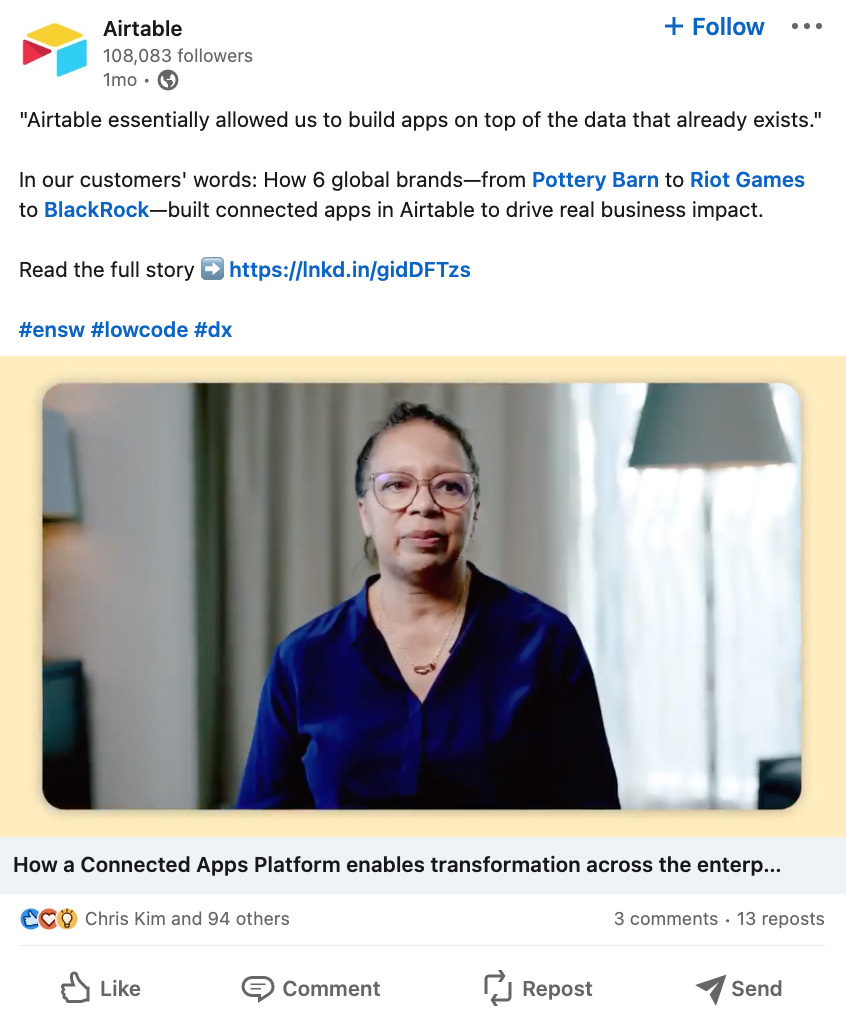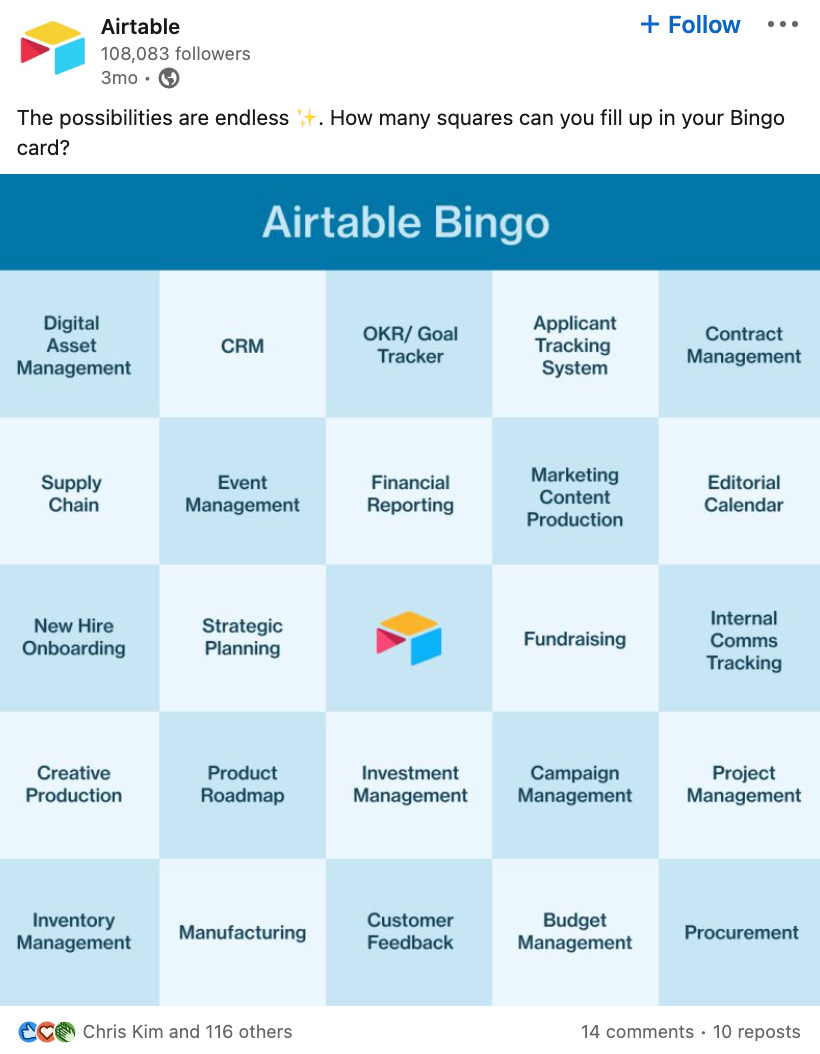by RACHEL KARTEN for Link In Bio
I’ll admit it: I’ve never thought of LinkedIn as a priority platform. Likely because most of the brands I’ve worked with are consumer-facing and I’ve generally found a lot of the posts on there fairly cringe.
But that’s changing. Between the reach I’ve gotten lately on personal posts promoting this newsletter and the potential demise of a not-to-be-named platform, I’m starting to see the LinkedIn light.
For today’s interview, I reached out to someone who has a lot of LinkedIn knowledge and has been a believer for awhile now. Chris Kim is the Director of Social Media at Airtable and has some serious B2B roots. We talk about what types of content perform best, why you should care about “deep quality metrics”, and how B2B is really just H2H.

Rachel Karten: First, can you tell me about your current job? And any previous social (or not) jobs you’ve had?
Chris Kim: I’m currently Director of Social Media at Airtable, which is a platform for building collaborative apps. Fast Company refers to us as a “Lego kit” for the workplace.
I’ve held social jobs since the pre-FB/Twitter days which really dates me! I’ve worked primarily for B2B tech brands including Workday, ServiceNow, Intuit, and Microsoft. It’s been a fun ride and as we know there’s never a dull moment!

RK: How would you describe your social media philosophy or your approach to this field?
CK: There’s an old business book called The Cluetrain Manifesto which in many ways foreshadowed the impact of the Internet on business relationships, marketing, and what would ultimately become social media.
To paraphrase the book: Markets are conversations, conducted by humans, and in a human voice. This translates to my overall philosophy, which is that through social media you can build genuine customer relationships which are both sustainable and have a measurable business impact.
RK: Smart. How important is a platform like LinkedIn for a B2B company like Airtable?
CK: LinkedIn has been a critical platform for B2B companies for several years as it evolved from being just a job board/online resume into a community where business professionals consume content. The pandemic and subsequent Great Reshuffle has further increased LinkedIn’s relevance, and today 4 of 5 LinkedIn members are business decision-makers.
When I first joined Airtable two years ago, LinkedIn was not a priority, as our original PLG (Product-Led Growth) model drove amazing organic word-of-mouth on Twitter and still does today. But as our enterprise business has grown and our company strategy has evolved, LinkedIn has quickly become a top priority as it impacts all phases of the customer journey in a measurable way.

RK: And how would you describe Airtable’s LinkedIn strategy?
CK: This has also been an evolution for us. We originally focused on brand awareness and just establishing a consistent presence on LinkedIn. Today our LinkedIn strategy has become more targeted to enterprises, yet at the same time more multifaceted to include community management, employee advocacy, and organic lead generation.
RK: What type of content do you feel performs best on a platform like LinkedIn?
CK: We’re always testing and iterating, but these content types have consistently performed well in support of our strategy:
- Text-only questions or polls. Whether we’re asking users for product tips or trying to understand their pain points, we often incorporate text-only content into our calendar.
- Document posts. The carousel-like experience of an embedded document is an underrated feature of LinkedIn. We use it to present data-rich content in a more visual way, which has given us a 4x lift in engagement. Note: LinkedIn has recently started rolling out native carousel functionality so keep an eye out for that!
- Native videos have a built-in benefit because they autoplay in-feed, which saves users a click compared to embedded YouTube videos. We’ve had success with short, native videos to demonstrate new product features and as teasers for longer videos.
- UGC spotlights. We love to make the customer the hero, and have created a weekly visual series to feature great UGC we’ve spotted on earned social. It’s a proven tactic at this point (other brands do this) and it works great on LinkedIn as a thumb-stopping visual.

RK: Super helpful. What metrics do you look at in terms of performance on that platform?
CK: We try to measure quantity and quality in tandem. For example, if your LinkedIn followers are growing at a far faster rate than your total engagements, then you may have followers who don’t add much value. Those followers could be competitors, old job applicants, or people who followed you for a transient reason (e.g. to enter a contest).
This year I’m layering on deeper quality metrics such as “# of LinkedIn engagements from companies with 1K+ employees” to align with our company strategy. And with new tools such as Common Room, I can now analyze LinkedIn engagements at the company and individual level, which has uncovered many actionable insights for our sales team.
RK: Is there a recent LinkedIn post you are particularly proud of? Tell me about it!
CK: We recently posted a Bingo card showing all the different ways you can use Airtable at work (in keeping with the Lego analogy). We’re proud of this post for multiple reasons:
- It reinforces our product differentiation, as we’re often viewed as a tool just for project management
- It’s consistent with our brand personality, which is playful but professional
- It is atypical of most content you see from B2B brands
- We also noticed that leaders from Fortune 500 companies engaged with this post, which illustrates how “fun” posts can also help uncover leads

RK: How does Airtable’s LinkedIn strategy differ from its strategy on other networks?
CK: LinkedIn is where our enterprise users and decision-makers live, which naturally guides our editorial approach. We also leverage our employees as brand advocates since most everyone has a LinkedIn presence, whereas a much smaller subset are active on Twitter. Lastly, from an analytics perspective, LinkedIn is unique in that everyone’s profile information is complete and fairly up-to-date. This allows you to tie your activities directly to customer actions, and you know who they are even if they don’t fill out a marketing form.
RK: What are three tips you’d give to a brand that wants to up their LinkedIn game?
CK:
- Engage in the comments. Even if it’s just to acknowledge someone else’s comment, it lets people know there’s a human behind your company handle. Remember that on LinkedIn, “community lives in the comments”!
- Add lo-fi content to your calendar. As a social media marketer, there’s a unique joy in seeing a text-only post that took seconds to write outperform a highly-produced asset 😈
- Share insights with your sales team. One of the highlights of my day is when I can Slack as a salesperson to tell them someone from one of their accounts is engaging with Airtable on LinkedIn. These interactions are not captured in Salesforce but can unlock new sales opportunities.

RK: Zooming out from LinkedIn—I’ve heard you speak before about how B2B marketing isn’t that different to B2C because both are really just marketing to humans. Can you tell me a little bit more about that?
CK: Even though B2B has a longer, more complex purchasing process than B2C, it’s still people who are making the buying decisions. As my friend Bryan Kramer says, “There is no more B2B or B2C: It’s Human to Human, H2H“.
Most purchases today start with self-serve education. You do a Google search, read online recommendations, evaluate competitors, and go to social for additional sentiment. As you’ve seen from the examples above, content that connects on an emotional level drives people to action. It’s no different in B2B than B2C. In B2B you do have to win both their hearts and minds, which I liken to high-value B2C purchases like cars or travel.
RK: Love that. Any final thoughts?
CK: The Human 2 Human theme also applies to your “internal marketing” as well, especially when demonstrating the value of social media to your execs. Whenever I’m presenting to internal teams, I always show live examples to reinforce the data insights. This allows you to tell a story with your metrics—and social media examples are often what leaders will remember the most!
